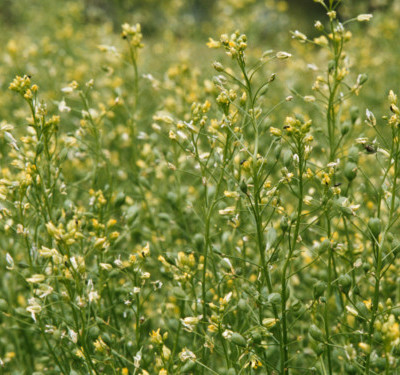Predicting crop growth
Researchers draw up a model that can help predict the best growing spots for a crop that can be used for biofuel
Published online 31 March 2015

Camelina sativa is originally native to Europe and to Central Asian areas and has been used as oilseed, but other regions have began growing it for its potential as biofuel.
© Philip Robinson / Alamy
Researchers in Argentina have developed an agricultural-climatic model to determine which areas in the country have the most favourable conditions for growing a promising and sustainable energy crop1.
Camelina sativa, commonly known as gold of pleasure or false flax, is a flowering plant of the mustard family, which is native to the Mediterranean and central Asia. It is used to make biofuel for the aviation industry, which reduces emissions of greenhouse gases by more than 80% compared to petroleum kerosene. It is also rich in omega-3 oils so could be a suitable food source.
In order to look for potential growing areas for the crop in Argentina, Silvia Falasca of the Water and Climate Institute in Buenos Aires and her colleagues analysed climate data from meteorological stations throughout the country between 1981 and 2010, focusing especially on variables such as average annual rainfall and temperature.
Argentina occupies a vast area of South America and has a variety of climates, largely determined by the Andean mountain range, which forms a natural border to the west, and the Atlantic ocean, to the east.
The model demonstrates that large areas are suitable for cultivating Camelina sativa, mostly in the northeast of the country (see map), while the southern parts of Argentina are less suitable or not suitable at all.
Several areas, located in the eastern region of the Chaco and Formosa provinces, the western region of Corrientes, the northern and central regions of Entre Ríos, and the central and eastern regions of Buenos Aires, have optimal conditions — they receive at least 350 mm of rainfall, and have average temperatures greater than 10 °C between mid-August and mid-December, the time of year during which Camelina sativa growth occurs.
The model also enabled the researchers to determine which of these areas are best suited for cultivating the crop for use as a food source, and where it would best be grown to harvest biofuel. To determine this, the researchers made sure that the production of biofuel in these areas would not be competing with the production of food crops.
The team contend that the same modelling approach can be used in other regions of the world as well to determine areas where Camelina sativa, which could offer new income models in rural areas.
Reference
- Falasca, S. L., del Fresno, M. C. & Waldman, C. Developing an agro-climatic zoning model to determine potential growing areas for Camelina sativa in Argentina. QScience Connect 2014, 4 (2014). | article
DOI: 10.1038/qsh.2015.56

